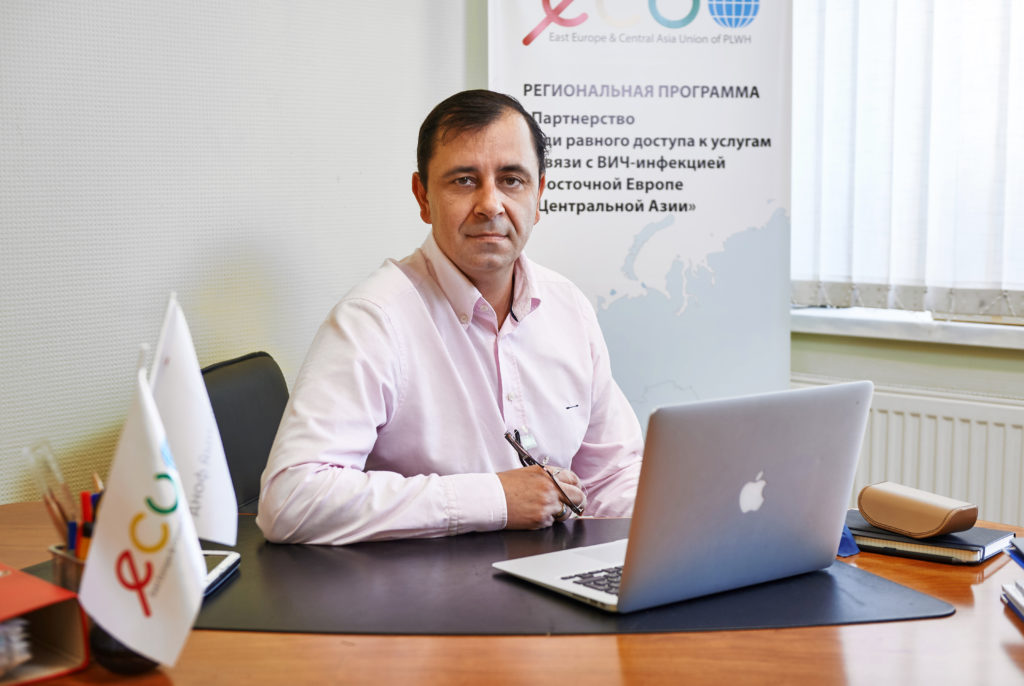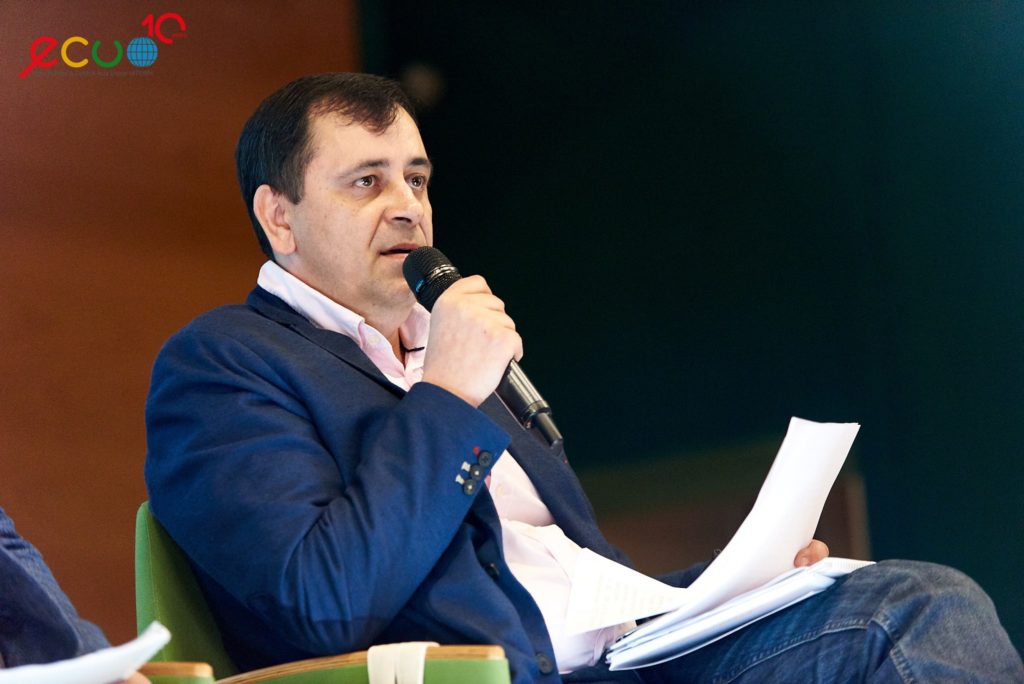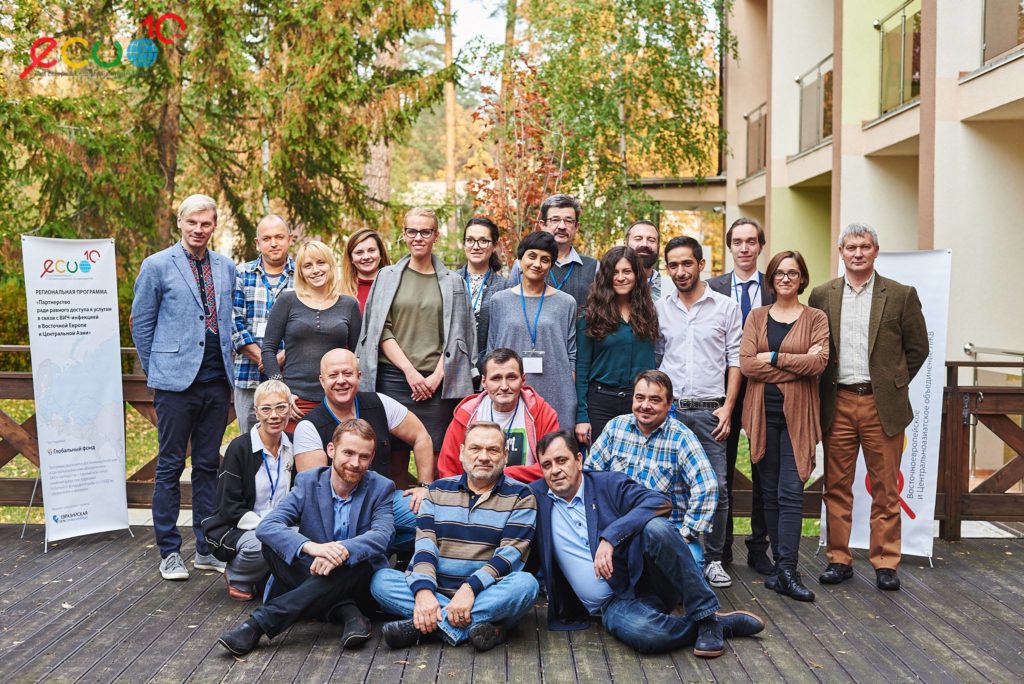In October the HIV/AIDS conference under a resounding slogan “Invisible Epidemic”, was held in Berlin, where the German experts expressed their concern about the situation with the HIV spread pace in Russia and in the Eastern Europe.
 The ECUO PLWH team has drawn attention of the international community to the catastrophic situation with the HIV/AIDS spread in the EECA region already 7 years ago, back in 2010 at the International HIV/AIDS Conference in Vienna. We came forward with a comprehensive awareness campaign «Less of us die, but we die faster!» to draw world leaders’ attention to the complicated situation with access to treatment and the surge of the HIV/AIDS epidemic in Eastern Europe and Central Asia.
The ECUO PLWH team has drawn attention of the international community to the catastrophic situation with the HIV/AIDS spread in the EECA region already 7 years ago, back in 2010 at the International HIV/AIDS Conference in Vienna. We came forward with a comprehensive awareness campaign «Less of us die, but we die faster!» to draw world leaders’ attention to the complicated situation with access to treatment and the surge of the HIV/AIDS epidemic in Eastern Europe and Central Asia.
Seven years passed since then, and the EECA remains the only region in the world where the epidemic continues to actively progress: the number of newly registered HIV cases is increasing rapidly, and AIDS mortality is on the rise. At the same time, Eastern Europe and Central Asia were and still remain the region with the poorest access to antiretroviral therapy.
I have to acknowledge that during the past decade the state of affairs has not improved, rather to the contrary, it has deteriorated. Unfortunately, the situation in the region is paradoxical. The spread of the HIV/AIDS epidemic in Russia is complemented and exacerbated by the absolute lack of science-based methods of working with key groups. Thus, substitution therapy programs for drug users are not operating in the country. Meanwhile, hundreds of millions of dollars of international assistance, in particular from the Global Fund and the US government, are being invested in harm reduction programs in Ukraine, but with all this support the country is ranked second after Russia in terms of HIV morbidity and AIDS mortality. On the other hand, state funding in Ukraine is increasing and, nevertheless, the epidemic continues to grow, mortality is increasing, and the dynamics of new HIV cases detection also shows an upward tendency.
This means that the government institutions, international organizations and the civil society should coordinate their activities to stop the epidemic.
Why HIV/AIDS response is failing?
In general, activities to combat the epidemic in the Eastern Europe and Central Asia countries are inefficient for several reasons.
On one hand, science-based methods of working with vulnerable groups are not recognized and applied, and on the other hand, the government pays extremely low attention to the prevention work. In particular, the primary prevention among schoolchildren, adolescents, vocational school students and, in fact, the general population is lacking. Today the number of HIV cases detection among the older age group is also increasing. Sexual transmission is becoming prevalent, which indicates that HIV already has infiltrated into the general population long ago.
Yes, we might claim these groups are sexual partners of drug users, sex workers, men who have sex with men, but, by and large, the affected are just ordinary citizens.
Recently I learned about the startling situation in a Ukrainian town. Just imagine that three chiefs of the district police departments were diagnosed with HIV, one of them refused to accept the fact of being infected and, unfortunately, already died of AIDS, rejecting to take ART. This situation seems to me a striking example, that should lead to obvious conclusions.
Undoubtedly, the causes of such dismal situation in the region are rooted, first of all, in failure to recognize efficient, targeted work among key groups; one of them is insufficient work on prevention among youth and schoolchildren. This is a lack of involvement and assurance in the treatment programs for all PLWH. And, in fact, presence of work in many area, instead of practical well-performing activities, is an important factor.

Joining the efforts of networks and communities in action
Realizing that the epidemic in our countries is progressing rather than ceasing, and our region is the only one in the world that has not yet reached the Millennium Development Goal 6 (MDG 6), we, as a regional network of PLWH, took up the initiative and gathered like-minded people around a single goal. The result of this cooperation was the Regional Report of Networks and Communities “Eastern Europe and Central Asia: Do not Leave Without Response“, which describes the situation with the spread of HIV among key groups in our countries, as well as specific recommendations for overcoming barriers to counteract the HIV/AIDS epidemic. This was done with the sole aim of taking joint control of the epidemic in the EECA region.
We prepared this report specially for the UN General Assembly on HIV/AIDS and presented it on the occasion. The report was highly appreciated and, in the framework of the Assembly, a special meeting was held with the ministers of health of the UN member states of the region to discuss the response to the HIV/AIDS epidemic in Eastern Europe and Central Asia (EECA). Based on this regional networks report, Michel Kazatchkine, UN Special Envoy on HIV/AIDS in the EECA region, held this working meeting jointly with me as the ECUO PLWH representative, focusing the attention of the state officials on the awful situation in the region.
By the end of the year our team will hold a number of events with the participation of international experts, representatives of regional networks, communities and country consortiums that will discuss regional strategy on access to treatment.
Attitude to HIV/AIDS problem as the society development indicator
It became evident that the HIV/AIDS epidemic has long spread beyond the key affected populations. Generally, the HIV/AIDS epidemic is not only a medical or social issue, it is a problem of the society’s attitude towards other people. This is a peculiar indicator of the society development as a whole and the individual consciousness in particular. This is a characteristic of the person who does not condemn, does not offend, does not humiliate, does not discriminate, does not look for the ones to blame for their problems, whereas the intolerant attitude was common in the USSR times.
Twenty years ago we might say that HIV is not a threat for us, it’s widespread somewhere in Africa. Nowadays in Africa the number of new HIV cases is dwindling, while in our countries it continues to grow. Therefore, HIV is a peculiar indicator and a problem, both medical and social, cultural, ideological and economic.

ART may become cheaper, as a successful experience shows
We know for sure that ARV medications can be made cheaper, we have a successful experience confirming that ART can be procured at a low price, and we are ready to share it. For example, the ECUO PLWH, together with UNICEF with the support of the Global Fund, conducted the first regional training program on ART procurement for the EECA country teams. During the training the UNICEF sales team shared its experience and best practices on ART procurement in the region at the lowest cost.
Among other activities, in our countries it is necessary to focus more on prevention, treatment, care and support programs for PLWH to ensure efficient epidemic response.
I, as well and the entire international team of ECUO PLWH, also welcome the UNAIDS Test and Treat strategy, which prescribes the treatment to all people newly diagnosed with HIV regardless of CD4 count. At the same time, obsolete medications are still being used in our region. Old-generation drugs have severe side effects, deteriorating the person’s health in general, as well as their psychological condition.
Imagine a person who has just learned that they are HIV-infected, they do not have any symptoms, do not feel any changes, practice active lifestyle, and they start to take ART because the doctor said “take these pills and you will live”. But these pills make them feel much worse. And, of course, people cease to take medications, the viral load progresses, and the patient continues to transmit the virus, which became already resistant to this medication.
To prevent these situations, ECUO PLWH, as the organization protecting the rights of people living with HIV, is striving to ensure high quality treatment for all PLWH of our region. We insist, that the Eastern Europe, Central Asia and the Caucasus are parts of the European region, that’s why we need to have the same treatment standards in place as in the European countries. It is necessary to treat all PLWH with the medicines with proven therapeutic efficiency and the least side effects. Thus, accepting this strategy and calling on the governments of the countries of Eastern Europe and Central Asia to introduce medicines already used in Europe, we not only allow the patients to have decent quality of life, but at the same time take a decisive step towards curbing the sexual transmission of a resistant HIV virus. And this is the best practice of counteracting the virus spread.
Summing up, I want to say that I am proud of our team, which back in 2010 managed to prepare an important report on the situation in EECA countries through the joint effort of the community, and communicated its results to managers of country and regional HIV/AIDS programs. We were drawing attention to the region that, like no other, needs current and future donor support for effective counteraction of the HIV/AIDS epidemic. Otherwise, the countries of the EECA region will be ravaged by the epidemic of such scale that its consequences will be disastrous for the entire world.
